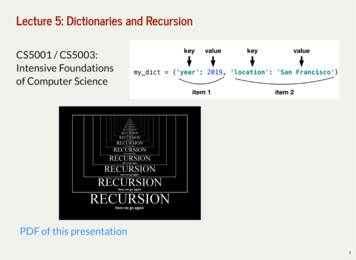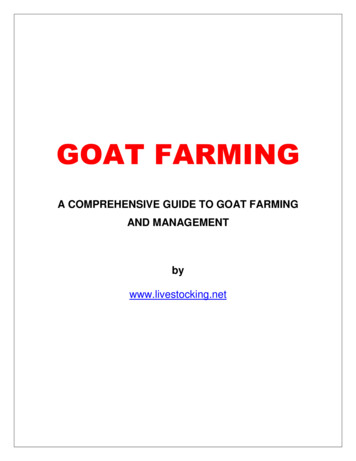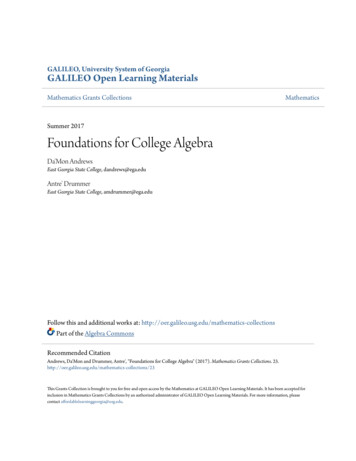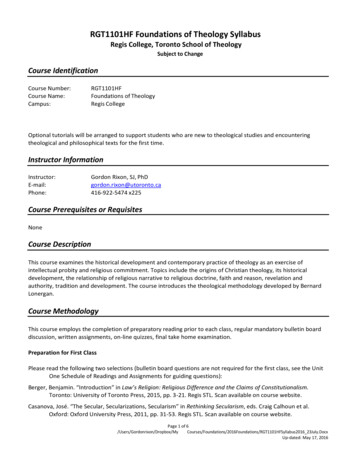
Transcription
Lecture 5: Dictionaries and RecursionCS5001 / CS5003:Intensive Foundationsof Computer SciencePDF of this presentation1
Lecture 5: Practice!Let's practice a few topics that I think some students are still unclear about:Looping a certain number of timesPrinting a comma-separated list without the last commaBreaking out of a while True loopPractice 1: Write a loop to print a string,s, X times (once per line), where X is thelength of the string. E.g., if the string is"bats":batsbatsbatsbats2
Lecture 5: Practice!Let's practice a few topics that I think some students are still unclear about:Looping a certain number of timesPrinting a comma-separated list without the last commaBreaking out of a while True loopPractice 1: Write a loop to print a string,s, X times (once per line), where X is thelength of the string. E.g., if the string is"bats":bats# solutionfor i in range(len(s)):print(s)batsbatsbats3
Lecture 5: Practice!Let's practice a few topics that I think some students are still unclear about:Looping a certain number of timesPrinting a comma-separated list without the last commaBreaking out of a while True loopPractice 2: print a list, lst, one value at a time and comma separated, without thelast comma.4
Lecture 5: Practice!Let's practice a few topics that I think some students are still unclear about:Looping a certain number of timesPrinting a comma-separated list without the last commaBreaking out of a while True loopPractice 2: print a list, lst, one value at a time and comma separated, without thelast comma.# solution #1lst ['cat', 'dog', 'bat', 'rat']for i, val in enumerate(lst):if i len(lst) - 1:print(val)else:print(f"{val}, ", end '')# solution #3lst ['cat', 'dog', 'bat', 'rat']print(', '.join(lst))# solution #2lst ['cat', 'dog', 'bat', 'rat']for v in lst[:-1]:print(f"{v}, ", end '')print(lst[-1])5
Lecture 5: Practice!Let's practice a few topics that I think some students are still unclear about:Looping a certain number of timesPrinting a comma-separated list without the last commaBreaking out of a while True loopPractice 3: Print random numbers between 0 and 99 until two numbers in a roware 90 or above6
Lecture 5: Practice!Let's practice a few topics that I think some students are still unclear about:Looping a certain number of timesPrinting a comma-separated list without the last commaBreaking out of a while True loopPractice 3: Print random numbers between 0 and 99 until two numbers in a roware 90 or above (stop after the two numbers above 90 have been printed)# Solutionlast 0while True:v random.randint(0,99)print(v)if v 90 and last 90:breaklast v7
Lecture 5: Calculating the frequencies of letters in a sentenceChallenge: calculate the frequencies of letters in a sentence. For example, thefrequencies of letters in "my dog ate my homework" would be:y ::d :o :g :a :t :e :h :w :r :k :241311121111There are two y's, four spaces, 1 d, three o's, etc.How might you write a program to print out those frequencies?Talk to your neighbor!8
Lecture 5: Calculating the frequencies of letters in a sentenceChallenge: calculate the frequencies of letters in a sentence. For example, thefrequencies of letters in "my dog ate my homework" would be:y ::d :o :g :a :t :e :h :w :r :k :241311121111There are two y's, four spaces, 1 d, three o's, etc.How might you write a program to print out those frequencies?Talk to your neighbor!One solution might look like this:sentence "my dog ate my homework"letter list []letter freqs []for c in sentence:if c not in letter list:letter list.append(c)letter freqs.append(1)else:letter freqs[letter list.index(c)] 1for c, freq in zip(letter list, letter freqs):print(f"{c} : {freq}")This seems kind of messy, though, since we have to keep two simultaneous lists.9
Lecture 5: Dictionaries: a better way!So far in CS5001, we have talked about the following types of data:integers, using int (e.g., 1, 5, -3, 18)floating point numbers, using float (e.g., 1.3, 8.2, 14.5)strings, using either single or double quotes (e.g., "hello", "me",'elephant')lists, using square brackets or list (e.g., a [1, 3, 5, 23, 99])tuples, using parentheses (e.g., a (1, 3, 5, 23, 99))Another very widely used data types is the dictionary, or dict.A dict is a set of key value pairs. As an example, let's say you wanted to storepeople's names with their phone numbers. You might have something like this:ChrisBeckyJenny434-2221867-5309685-6587In this case, the keys are thenames, and the values are thephone numbers. If you want avalue, you ask for it by the key.10
Lecture 5: 7In Python, we can create a dictionary as follows:phonebook {'Chris' : '685-6587', 'Becky' : '434-2221', 'Jenny' : '867-5309'}To get a value for a key, we use square brackets: phonebook['Chris']'685-6587' phonebook['Becky']'434-2221' phonebook['Jenny']'867-5309'11
Lecture 5: -6587867-5309A dictionary can have the same values, but all keys must be distinct. Let's say wewanted to add "John" to our phonebook:phonebook {'Chris' : '685-6587', 'Becky' : '434-2221', 'Jenny' : '867-5309'}phonebook['John'] '867-5309'print(phonebook){'Chris': '685-6587', 'Jenny': '867-5309', 'John': '867-5309', 'Becky': '434-2221'}Notice that the order when we printed wasn't the order we added the elementsin! This is because dictionaries are not ordered, and you cannot rely on them to bein a certain order. This is important to remember!12
Lecture 5: DictionariesDictionaries are useful for many things. Take a look at this program:sentence "the quick brown fox jumps over the lazy dog"frequencies {}for c in sentence:if c not in frequencies:frequencies[c] 1else:frequencies[c] 1for key, value in frequencies.items():print(f"{key} : {value}")What does it do?13
Lecture 5: DictionariesDictionaries are useful for many things. Take a look at this program:sentence "the quick brown fox jumps over the lazy dog"frequencies {}for c in sentence:if c not in frequencies:frequencies[c] 1else:frequencies[c] 1for key, value in frequencies.items():print(f"{key} : {value}")This program figures out how many of each letter are in the sentence! Output:t : 2h : 2e : 3: 8q : 1u : 2i : 1c : 1k : 1b : 1r : 2o : 4w : 1nfxjmpsvlazydg::::::::::::::11111111111111This is exactly the same program as we wroteearlier, except much less messy. Notice we simplyadded a new character (as key) to the dictionary ifthe character wasn't already in the dictionary, andif it was in the dictionary, we simply updated thecount.14
Lecture 5: DictionariesLet's take a look at a larger program, and test a couple of things.We are going to read in a full book, and count the frequency of the words.We will have two different functions -- one that uses a list to create the frequencycount, and the other that uses a dictionary.Here is the function using a dictionary:1 def get word freqs dict(filename):word frequencies {}2word count 03with open(filename) as f:4for line in f:5line ''.join(ch for ch in line if ch.isalnum() or ch ' ').lower()6words line.split(' ')7for word in words:8word count 19if word count % 1000 0:10print(f"Found {word count} words.")11if word not in word frequencies:12word frequencies[word] 11314else:15word frequencies[word] 116return word frequencies15
Lecture 5: DictionariesHere is the function using lists. We convert the result to a dictionary at the end tomake the return value of both functions the same:1 def get word freqs list(filename):word strings []2word frequencies []3word count 04with open(filename) as f:5for line in f:6line ''.join(ch for ch in line if ch.isalnum() or ch ' ').lower()78words line.split(' ')9for word in words:10word count 1if word count % 1000 0:1112print(f"Found {word count} words.")if word not in word strings:13word strings.append(word)14word frequencies.append(1)15else:16word frequencies[word strings.index(word)] 117return dict(zip(word strings, word frequencies))18The functions aren't that different, so you might be wondering why we would useone or the other.16
Lecture 5: DictionariesHere is the driver for the function. Notice that we can easily test both functions byuncommenting / commenting two lines:1 if name " main ":2# word freqs get word freqs dict(BOOK FILE)word freqs get word freqs list(BOOK FILE)3print(f"There are {len(word freqs)} unique words in {TITLE}")4while True:5word input("Word? ").lower()6if word in word freqs:78print(f"'{word}' is found {word freqs[word]} time(s) in {TITLE}")Let's go see the code and run it.17
Lecture 5: DictionariesWhat happened?The dictionary version was way faster!Why?This happened because dictionaries are using a special type of data structurecalled a hash map. You will learn about hash maps in your next course (on datastructures), but just know that dictionaries allow fast-lookup of their keys.In contrast, how would we have to find if a word was in a list?We would have to search every item in the list until we found the value. Thiscould take a while for long lists!If you want to do this thousands of times for a large data set, you're going tohave a bad day!Note: you could use a list with a different type of search if you first sorted thelist, but sorting takes time, too, and keeping a list sorted is also time consuming(when you add another item, etc.)18
Lecture 5: DictionariesIf you want to get a list of just the keys or just the values in a dictionary, you can doit like this:123456 phonebook {'Chris': '685-6587', 'Jenny': '867-5309', 'John': '867-5309', 'Becky': '434-2221'} phonebook.keys()dict keys(['Chris', 'Jenny', 'John', 'Becky']) phonebook.values()dict values(['685-6587', '867-5309', '867-5309', '434-2221']) Note: these are actually not lists, but you can treat them as lists. You could alsoturn them into lists as follows:123456 phonebook {'Chris': '685-6587', 'Jenny': '867-5309', 'John': '867-5309', 'Becky': '434-2221'} list(phonebook.keys())['Chris', 'Jenny', 'John', 'Becky'] list(phonebook.values())['685-6587', '867-5309', '867-5309', '434-2221'] Remember -- you won't get the keys or values in any particular order (though bothlists will be in the same order). Dictionaries are not sorted!Also notice above that the keys are always unique, but the values don't have to beunique (and there are two '867-5309' values in this example).19
Lecture 5: DictionariesSimilar to lists and tuples, dicts can hold different types as either their keys ortheir values. Frequently, we will want to keep a dict of string keys, with varioustypes for their values. Example:1 actor details {2'first name' : 'Scarlett',3'last name' : 'Johansson',4'movies': ['Lost in Translation', 'Girl with a Pearl Earring',5'The SpongeBob SquarePants Movie', 'The Avengers'],6'age' : 34,'birthday' : 'November 22, 1984',78 }Note that we have nicely formatted this -- one key/value pair per line (exceptwhen the lines are too long).Notice as well that the values are different types -- we have strings, lists, and intsas values.Finally -- this may seem weird, but we can also end the last item with a comma,even though there aren't more items. This is allowed by Python, and somethingyou will see often (you can also leave off the trailing comma).20
Lecture 5: Dictionaries1 actor details {2'first name' : 'Scarlett',3'last name' : 'Johansson',4'movies': ['Lost in Translation', 'Girl with a Pearl Earring',5'The SpongeBob SquarePants Movie', 'The Avengers'],6'age' : 34,7'birthday' : 'November 22, 1984',8 }How would we access each item in this dict? With bracket notation:12345print(f"The actor's name is {actor details['first name']} {actor details['last name']}, and")print(f"the actor was in the following films:")for film in actor details['movies']:print(f" {film}")print(f"The actor is {actor details['age']} years old and was born on {actor details['birthday']}")Output:The actor's name is Scarlett Johansson, andthe actor was in the following films:Lost in TranslationGirl with a Pearl EarringThe SpongeBob SquarePants MovieThe AvengersThe actor is 34 years old and was born on November 22, 198421
Lecture 5: RecursionTo understand recursion, you must understand recursion.22
Lecture 5: RecursionIn computer science, recursion simply means that a function will call itself.1 def calc factorial(n):2if n 1:3return n4else:5return n * calc factorial(n-1)1 print(factorial(5))2 120The following program is pretty simple (and will crash!), but it is anotherexample of recursion: recurse(1)1 def recurse(x):print(x)2recurse(x 1)3Output:12345.994995Traceback (most recent call last):File " stdin ", line 1, in module File " stdin ", line 3, in recurseFile " stdin ", line 3, in recurseFile " stdin ", line 3, in recurse[Previous line repeated 992 more times]File " stdin ", line 2, in recurseRecursionError: maximum recursion depth exceeded whilecalling a Python object 99623
Lecture 5: RecursionIn computer science, recursion simply means that a function will call itself.1 def calc factorial(n):2if n 1:3return n4else:5return n * calc factorial(n-1)1 print(factorial(5))2 120The following program is pretty simple (and will crash!), but it is anotherexample of recursion: recurse(1)1 def recurse(x):print(x)2recurse(x 1)3The function callsitself!Output:12345.994995Traceback (most recent call last):File " stdin ", line 1, in module File " stdin ", line 3, in recurseFile " stdin ", line 3, in recurseFile " stdin ", line 3, in recurse[Previous line repeated 992 more times]File " stdin ", line 2, in recurseRecursionError: maximum recursion depth exceeded whilecalling a Python object 99624
Lecture 5: Recursion: How to solve a jigsaw puzzle recursivelyHow to solve a jigsawpuzzle recursively(“solve the puzzle”)Is the puzzlefinished? If so,stop.Find a correctpuzzle piece andplace it.Solve the puzzle25
Lecture 5: Recursion: How to solve a jigsaw puzzle recursivelyHow to solve a jigsawpuzzle recursively(“solve the puzzle”)Is the puzzlefinished? If so,stop.Find a correctpuzzle piece andplace it.Solve the puzzleRidiculously hard puzzle26
Lecture 5: Recursion: The algorithmIn general, to perform a recursive algorithm:Check for the base case. This is the case where the problem has beensolved, and we can stop. We normally we return a result, but notalways.Work towards the base case.Perform a recursive call on our own function.27
Lecture 5: Recursion: Counting downHow to count down recursively from N to 0:Is N less than 0? If yes, then stop (this the base case)Say N (this is working towards the base case, along with the first partof step 3 below)Count down from N-1 (this is the recursion!)1 def count down(count):2if count 0:3return4print(count)5count down(count - 1)On line 2, we check the base case: have we reached 0 yet?On line 3 we print (say) the countOn line 4 we work toward the base case, by calling count down with onefewer value.28
Lecture 5: Recursion: Counting upWhat about counting up? Maybe add another variable?1 def count up(count, maximum):2if count maximum:3return4print(count)5count up(count 1, max)This works, but it is kind of ugly. We have to add a second number. It doeshave more functionality, though, because we can start the the count atany number.29
Lecture 5: Recursion: Counting upThis version is actually very interesting!1 def count up(count):if count 0:23return4count up(count - 1)5print(count)This works, and is pretty cool. All of the counting happens before anythinggets printed. Let's walk through this.30
Lecture 5: Recursion: Counting upLet’s look at some other common recursive functions (not all areefficient!!):nbpower(b,n)factorial(int n);fibonacci(int n); (one way is not efficient!)isPalindrome(string s)31
Lecture 5: Recursion: Counting upLet’s look at some other common recursive functions (not all areefficient!!):nbpower(b,n)1 def power(b, n):2if n 0:3return 14return b * power(b, n - 1) print(power(2,3))832
Lecture 5: Recursion: Counting upLet’s look at some other common recursive functions (not all areefficient!!):factorial(n)Recursive:1 def calc factorial(n):2if n 1:3return n4else:5return n * calc factorial(n-1)Iterative:1 def calc factorial iterative(n):2product 13while n 0:4product * n5n - 16return productThe iterative function works just fine! Some might argue that therecursive function is more beautiful, but it is not quite as efficient, nor canit calculate factorials that are too big.33
Lecture 5: Recursion: Counting upLet’s look at some other common recursive functions (not all areefficient!!):fibonacci(n)Not efficient!1 def fibonacci(n):2if n 0:3return 04if n 1:5return 16return fibonacci(n - 1) fibonacci(n - 2)Efficient withhelper function1 def fibHelper(n, p0, p1):if n 1:2return p13return fibHelper(n - 1, p1, p0 p1)456 def fibonacci2(n):if n 0:7return 08return fibHelper(n, 0, 1)934
Lecture 5: Recursion: Counting upLet’s look at some other common recursive functions (not all areefficient!!):is palendrome(s)1 def is palendrome(s):# check base case2if len(s) 2:3return True4# check if the first and second character match5# if they do, recursively check the rest of the string6if s[0] s[-1]:7return is palendrome(s[1:-1])8return False935
of Computer Science . Another very widely used data types is the dictionary , or dict. A dict is a set of key value pairs . As an example, let's say you wanted to store people's names with their phone










